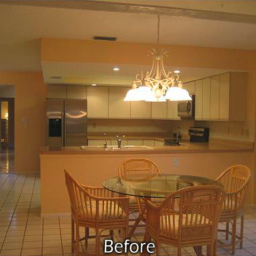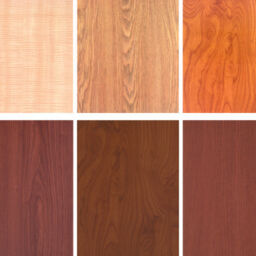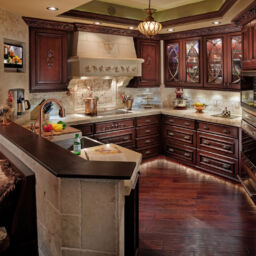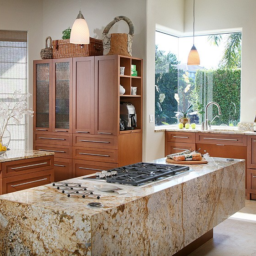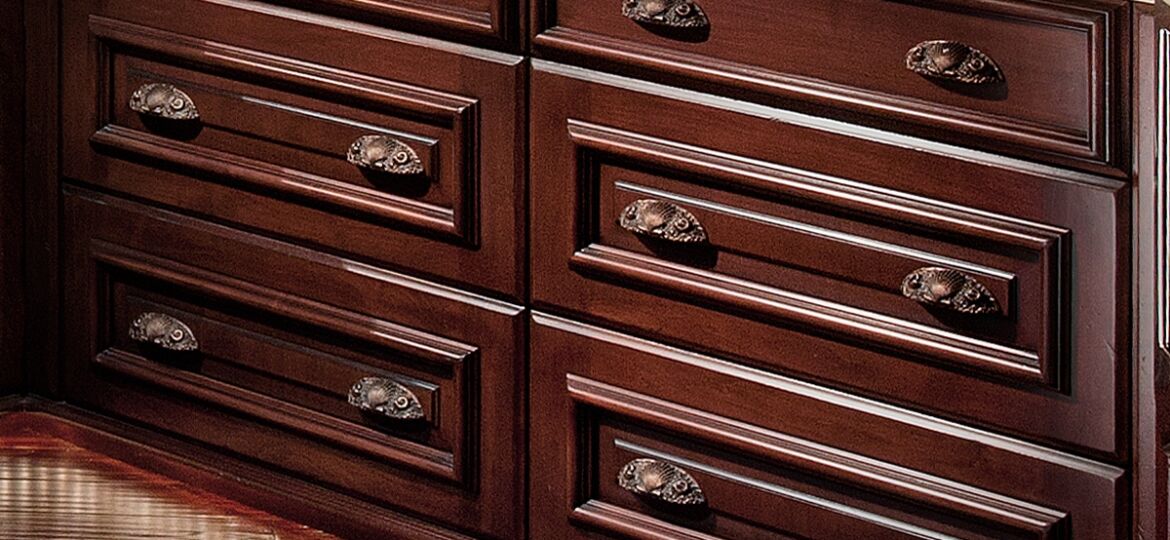
Whether you are shopping for custom cabinetry for your kitchen, bath or even new built-ins for your home office, be sure to check out some of the gorgeous hardwoods we offer. With unique grain patterns and a variety of ways to stain and finish them, you can find the perfect custom cabinets for your home.
Maple
Quilted maple, curly maple, birdseye maple – these are just a few examples of figured maple patterns that can make gorgeous custom cabinets. Birdseye maple is a rare pattern that occurs in less than one percent of all sugar maple trees. It’s characterized by the many small “eyes” that give the wood an exotic, dotted look. Quilted maple has a wavy distortion pattern across the grain that is reminiscent of rippling waves, while curly maple has a tight grain pattern that takes sharp twists and turns. Like quilted maple, curly maple also has distortion waves that give the wood an ever-changing look. Maple is naturally a light colored wood. Some people opt to preserve its natural color, but maple is very easily stained. You can choose from many different shades, and you need not worry about hiding the grain pattern with dark colors.
Anigre
Anigre is a tropical wood from Africa. The grain is fine and straight, which makes a beautiful uniform look when anigre is flat-sawn. Quarter-sawn anigre develops gorgeous horizontal ripples that are highly prized for cabinetry and other furniture applications. Anigre is very easy to stain, although many enjoy finishing it with a clear coat to preserve the natural yellow-browns and pinkish highlights. The ability to polish anigre to a bright sheen sets it apart from many other species.
Lacewood
Lacewood comes from Australia, South America and Brazil. This beautiful species is named for it’s bold mottled or flecked appearance. Lacewood’s natural color is a medium red-brown, often with lighter brown rays. When lacewood is quarter-cut, those rays can enhance the lacy look even more. Most people that choose lacewood for their cabinetry prefer to leave it natural, but lacewood does take stains quite well. Dyes are sometimes used to darken the grain, making for bold, intricate patterns.
Satinwood
There are two popular types of satinwood: East Indian satinwood and West Indian satinwood. The main difference between the two species is not their looks, but their origins. East Indian satinwood comes from southern India, while West Indian satinwood originates in the Caribbean. The species takes its name from the rippled grain pattern, which is very similar to rippled satin fabric. It comes in a range of colors, from a light golden tone to brown with an orange tint. Satinwood lends itself very well to a variety of stains, and it can also be polished to a smooth shine.
English Sycamore
This species is a hybrid of the American Sycamore and the Oriental Plane. When it is flat-sawn, it’s often confused with maple because it has a straight to moderately figured grain. In it’s quarter-sawn form, English Sycamore looks much like lacewood, with glowing rays and flecks. In many pieces of English Sycamore, the pale sapwood and red-brown heartwood blend to create interesting two-tone patterns. Although English Sycamore is easy to stain, boards and veneers with mixed heartwood and sapwood are often left natural for the bold bi-color effect.
Zebrawood
Another popular choice for custom cabinets, zebrawood has a light almond color with a dark brown to black grain. If the wood is quarter-sawn, the grain is relatively straight. Flat-sawn zebrawood often has a wild, wavy grain. Zebrawood can be stained, but it’s not normally recommended since it can obscure the dark stripes that make this species unique.

